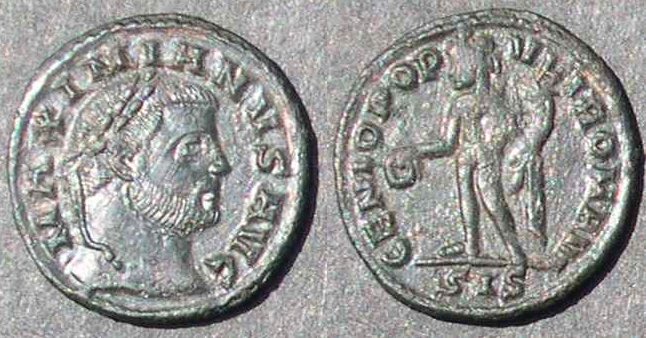 The Roman quarter-follis denomination frequencies
The Roman quarter-follis denomination frequencies
The main page on the quarter follis denomination, struck 305-306, at Siscia, is here. This page gives the relative frequencies of the ten types.
Coin to the right: Galerius as Augustus.
MAXIMIANVS AVG, laureate head right.
GENIO POPVLI ROMANI, Genius standing left with patera and cornucopia
SIS in exergue, for the Siscia mint (now in modern Croatia).
(This is the reverse design of all the types.)
RIC VI Siscia 169b.
Quarter-follis frequencies
| Ruler and type |
RIC VI, Siscia
number
and *rarity
|
Full legend |
MA
Coll |
Wd
Coll
|
Sum |
% of
total |
| Maximian type 1 |
142 R2 |
IMP C MA MAXIMIANVS PF AVG |
57 |
45 |
102 |
24.5 |
| Maximian type 2 |
147 R3 |
IMP C MA MAXIMIANVS AVG |
1 |
2 |
3 |
0.7 |
| Constantius type 3 |
167 R |
IMP C CONSTANTIVS PF AVG |
39 |
26 |
65 |
15.6 |
| Constantius type 4 (*DNE) |
168 R2 |
IMP CONSTANTIVS PF AVG |
0 |
0 |
0 |
0 |
| Constantius type 5 |
169a R2 |
CONSTANTIVS AVG |
15 |
8 |
23 |
5.5 |
| Galerius type 6 |
169b R |
MAXIMIANVS AVG |
32 |
23 |
55 |
13.2 |
| Severus II type 7 |
170a R |
FL VAL SEVERVS NOB C |
42 |
33 |
75 |
18.0 |
| Severus II type 8 |
171a R |
SEVERVS NOB C |
13 |
14 |
27 |
6.5 |
| Maximinus II type 9 |
170b R |
GAL VAL MAXIMINVS NOB C |
25 |
12 |
37 |
8.9 |
| Maximinus II type 10 |
171b R |
MAXIMINVS NOB C |
16 |
7 |
23 |
5.5 |
| *probable error variety |
not in RIC |
GAL VAL MAXIMINVS PF AVG |
4 |
1 |
5 |
1.2 |
| *Maximian faulty legend |
not in RIC |
IMP C MA MAXIMIANVS PP AVG |
1 |
0 |
1 |
0.2 |
| total |
|
|
245 |
181 |
416 |
100% |
Note: It is likely the types with low numbers are overrepresented. That is, they are rarer than they appear here. When a collector already has many coins of a design and is shown a number of examples to possibly buy and add to the collection, he might buy the whole batch, but is more likely to select types he recognizes as rare, which increases the representation of the rarer types.
MA Coll = A private collection, counted April 20, 2010.
Wd Coll = A private collection, counted September 23, 2021.
*DNE = Does Not Exist (It is in RIC but does not exist)
* The coins from the "probable error variety" are all from the same die.
* The "PP" of the faulty legend might be the normal "PF" deformed from die wear or the strike. I do not consider this a type different from type 1.
*The RIC rarities in column 2 are from RIC VI which was published in 1973. After the Iron Curtain came down in the 1990s, a flood of coins from the region of Siscia commenced and has not let up. The rarities of coins from that region have changed dramatically. These types, formerly "very rare" (R2) or "rare" (R, as listed in the table above) have mostly become only "rare" or "scarce" and some are now almost common, although there are still dozens of GENIO POPVLI ROMANI folles for every quarter follis.
Return to the main page on the quarter-follis denomination.
Go to the Table of Contents for this educational site.
 The Roman quarter-follis denomination frequencies
The Roman quarter-follis denomination frequencies